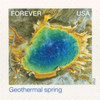
2012 First-Class Forever Stamp,Earthscapes: Geothermal Spring
# 4710c - 2012 First-Class Forever Stamp - Earthscapes: Geothermal Spring
$2.25 - $5.75
U.S. #4710c
2012 45¢ Geothermal Spring
Earthscapes
2012 45¢ Geothermal Spring
Earthscapes
Issue Date: October 1, 2012
City: Washington, DC
City: Washington, DC
Quantity: 2,670,000
Printed By: Banknote Corporation of America, Sennett Security Products
Printing Method: Offset
Perforations: Die Cut 10 ¾
Color: multicolored
Yellowstone National Park contains about 10,000 geothermal features including springs, geysers, and mud pots. The water is heated below the earth’s surface by coming in contact with molten rock from volcanoes. The geothermal springs are among the most colorful sights at Yellowstone.
Geologists with the Hayden Geological Survey of 1871 discovered a hot spring that displayed the colors of the rainbow. They named it the Grand Prismatic Spring, and it is the largest hot spring in the United States.
As with all geothermal springs, the colors observed by the geologists are the result of bacteria living on the edges of the 370-foot wide, 120-foot deep pool. Different types of organisms thrive in varying temperatures of water, which, along with seasonal temperatures, account for changes in color. The center of the spring is always a deep blue color, because the extreme heat prevents bacterial growth.
An estimated 560 gallons of water are released from the spring each minute. It flows over the edges and deposits white silica on the ground, forming a snowlike covering. The ground forms a frame around the geothermal spring, bringing attention to the brilliant array of colors.
U.S. #4710c
2012 45¢ Geothermal Spring
Earthscapes
2012 45¢ Geothermal Spring
Earthscapes
Issue Date: October 1, 2012
City: Washington, DC
City: Washington, DC
Quantity: 2,670,000
Printed By: Banknote Corporation of America, Sennett Security Products
Printing Method: Offset
Perforations: Die Cut 10 ¾
Color: multicolored
Yellowstone National Park contains about 10,000 geothermal features including springs, geysers, and mud pots. The water is heated below the earth’s surface by coming in contact with molten rock from volcanoes. The geothermal springs are among the most colorful sights at Yellowstone.
Geologists with the Hayden Geological Survey of 1871 discovered a hot spring that displayed the colors of the rainbow. They named it the Grand Prismatic Spring, and it is the largest hot spring in the United States.
As with all geothermal springs, the colors observed by the geologists are the result of bacteria living on the edges of the 370-foot wide, 120-foot deep pool. Different types of organisms thrive in varying temperatures of water, which, along with seasonal temperatures, account for changes in color. The center of the spring is always a deep blue color, because the extreme heat prevents bacterial growth.
An estimated 560 gallons of water are released from the spring each minute. It flows over the edges and deposits white silica on the ground, forming a snowlike covering. The ground forms a frame around the geothermal spring, bringing attention to the brilliant array of colors.













